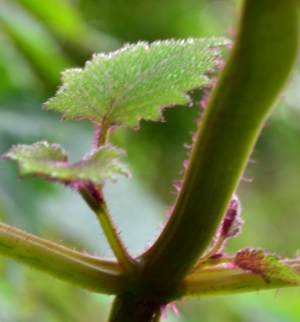Plectranthus swynnertonii
Plectranthus swynnertonii S.Moore
Family: Lamiaceae
Common names: Swynnerton's spur flower, cress spur flower; Debengeni spoorsalie (Afr.)
Introduction
Plectranthus swynnertonii is an attractive, fast growing late summer to winter flowering herbaceous perennial that will thrive in a moist frost-free garden.

Description
Description
Plectranthus swynnertonii is a herbaceous perennial to 600 mm high. Its habit is decumbent and the plant can be considered a groundcover. The square stems have a band of purple hairs at the base of their nodes with dense hairs at the tip.

The leaves are deeply serrated at the top, membranous, broadly ovate, with sparse stiff closely appressed hairs or smooth. Leaves are scented when crushed. The honey-coloured glands are flattened. Flowers summer to winter and in mild climates sporadically year round. Peak flowering in early winter. Whorls of 2-6 flowers are arranged along a 50-150mm terminal raceme. Corolla is white to pale pink, 10-12mm long, shaped like a pouch at the base and narrowing towards the throat. Calyx 5mm and elongates to 8mm after flowering. Nutlets are dark brown and 1.75mm long. The membranous, deeply dissected leaves and small saccate (pouched) corolla are distinctive of P. swynnertonii.
Conservation Status
Status
Plectranthus swynnertonii is not threatened.
Distribution and habitat
Distribution description
It occurs at altitudes of 765-1495 m, from Mpumalanga in South Africa through to the Chimanimani Mountains in eastern Zimbabwe, and Mount Mulanje in south Malawi. Swynnerton's spur flower prefers moist Afromontane forest and is a ground cover, often found along stream banks in frost free areas.
Derivation of name and historical aspects
History
The genus Plectranthus was first described in 1788 by Charles Louis L'Héritier de Brutelle (1746-1800), a French magistrate and keen botanist. He described the genus from the then unknown Plectranthus fruticosus which had a distinctive spur at the base of the corolla. The genus name is composed of plecton, meaning spur, and anthos, which refers to the flower. At the time L'Héritier did not know that many Plectranthus species did not have this spur and so 'spur flower' was accepted as the name for the genus and names published later, such as Germanea, became synonyms.
The species was named after its first collector, Charles Francis Massy Swynnerton (1877-1938), an English naturalist who collected Plectranthus swynnertonii in Chirinda Forest.
Ecology
Ecology
Plectranthus species are insect-pollinated. The pollen on the anthers ripens before the style to prevent self-pollination. Once the pollen is released, the anthers curve backwards to allow the style to become more prominent and allow for better pollination by visiting insects.
Uses
Use
Various Plectranthus species have long been used as ornamental bedding plants. In general they are easy to propagate and grow. They make attractive shady flower shows in late summer and winter when little else gives colour in the garden.

Growing Plectranthus swynnertonii
Grow
Plectranthus species are generally easy to propagate and will root from tip or stem cuttings in warm weather, although they can be propagated throughout the year. Propagate cuttings by using a basic propagation media or even just in a glass of water.
Sow seeds in a well-drained loam mix in spring. Seeds should readily germinate within three weeks. Transplant seedlings as soon as they are easy to handle. A growth media of well-drained sandy loam or compost rich soil produces lush vigorous plants.
Plectranthus swynnertonii can be grown in pots, but quickly outgrow them and will require potting on and regular foliar feeding in order to flower well. They are best suited as a groundcover or low shrub in a moist shady area.
A light prune to shape is encouraged after flowering.
Plectranthus species do get pests and diseases such as nematodes, caterpillars, aphids, white fly, scale, red spider mite and snails. However, in general Plectranthus species are quite hardy and rarely any trouble to a gardener.
References
- Van Jaarsveld, E. 2006. The Southern African Plectranthus and the art of turning shade to glade . Fernwood Press, Simon's Town.
- http://redlist.sanbi.org/
- http://www.jstor.org/
Credits
Monique McQuillan
Kirstenbosch National Botanical Garden
April 2014
Plant Attributes:
Plant Type: Perennial
SA Distribution: Limpopo
Soil type: Loam
Flowering season: Early Summer, Late Summer, Autumn, Winter
PH: Acid, Neutral
Flower colour: White
Aspect: Shade
Gardening skill: Easy
Special Features:
Horticultural zones








Rate this article
Article well written and informative
Rate this plant
Is this an interesting plant?
Login to add your Comment
Back to topNot registered yet? Click here to register.